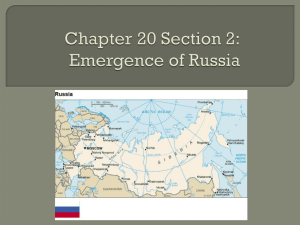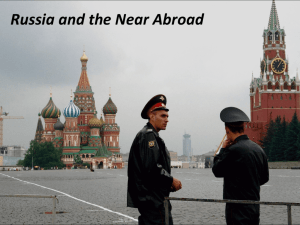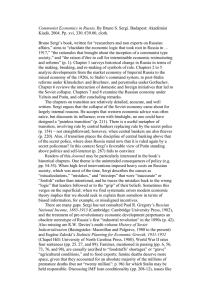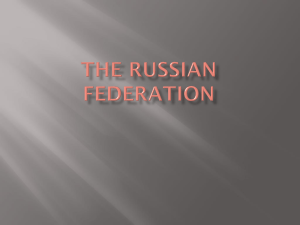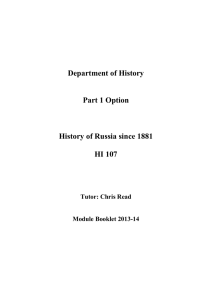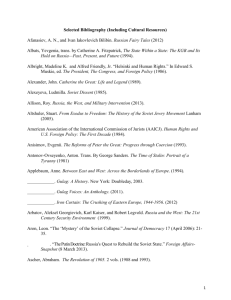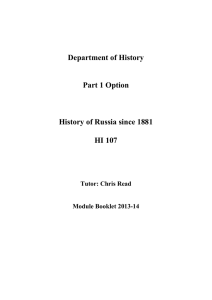World Geography Europe & Russia Notes
advertisement
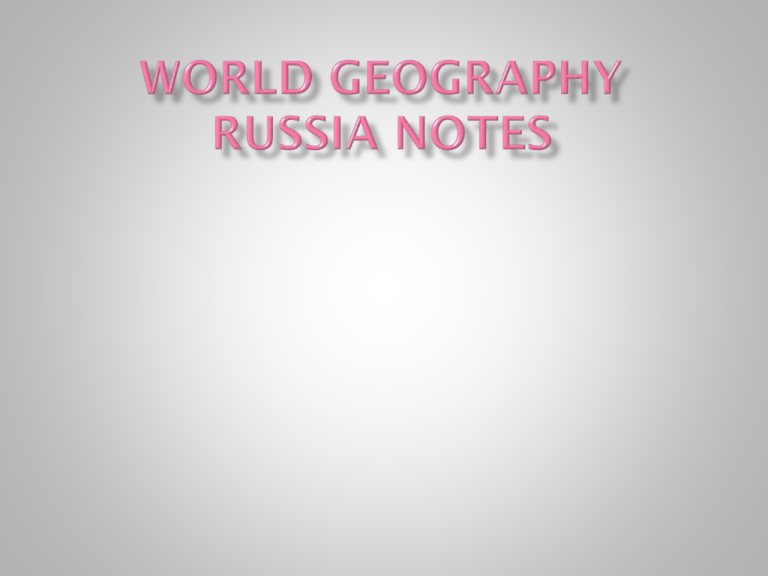
Russia and the Republics cover 1/6 of earth’s land surface 8 1/2 million square miles Three times the land area of U.S. - Russia spans 11 time zones Distance decay—longdistance communication, transportation are hard 1. Adygea 2. Altai 3. Bashkortostan 4. Buryatia 5. Dagestan 6. Ingushetia 7. Kabardino-Balkaria 8. Kalmykia 9. Karachay–Cherkessia 10. Karelia 11. Komi 12. Mari El 13. Mordovia 14. Sakha (Yakutia) 15. North Ossetia–Alania 16. Tatarstan 17. Tuva 18. Udmurtia 19. Khakassia 20. Chechnya 21. Chuvashia 22. Crimea Caspian Sea - largest inland sea in world - 750-mile-long (north to south) saltwater lake Aral Sea - east of Caspian, is also saltwater - has lost 80% of water volume since 1960 due to irrigation Lake Baikal - Deepest & oldest lake in the world - a mile from surface to bottom at deepest point - 400 miles long, holds 20% of world’s fresh water - home to 2,500 unique plant & animal species Many of Russia’s resources are in Siberia - frigid, arctic Russian area of Asia Hard to get at & move resources due to climates, terrain & distances taiga—largest forest on earth located in Russia - Produces 1/5 of the world’s timber Humid continental and subarctic climates dominate region Continentality - effect the region’s enormous size has on its climates -Distance from sea decreases precipitation -moisture from Atlantic Ocean is lost further inland Distance from sea also creates extreme temperatures Siberia – average temperatures are usually below 50 degrees F - Siberian temperatures can drop below –90 degrees F Region has layer of permafrost that can reach depths of 1,500 feet Buildings on permafrost sink and fall when their heat thaws ground - buildings must be set off ground on concrete pillars What body of water is Eastern Europe farther away from than Western Europe which results in it having a harsher climate? What mountains divide Europe from Asia? What do people who believe Europe & Asia are one continent call it? What is the oldest & deepest lake in the world? What region in Russia has many resources & a very cold climate cold climate? How many time zones does Russia cross? What is Taiga Why do builders in Siberia have to take special precautions with their buildings? What is the largest inland sea in the world? What is distance decay? 9th century- Vikings from Scandinavia established a settlement near Kiev, soon the settlement began to expand. Expansion halted in the 13th century, invasion of the Mongols (Tatars). Who controlled the region until the 1500s Ivan the Great (prince of Moscow), ended their rule. Also the first czar of Russia. Extended territory. By the 17th century the empire expanded to the Pacific Ocean. Rapid territorial growth, but less than impressive advances in technology. Peter the Great (czar from 1682-1725) moved capital to St. Petersburg “window to the west.” Made strides in modernizing Russia However, didn’t develop industry until the end of the 19th century (W. Euro- mid 19th) Industry: harsh working conditions and low wages contributed to resentment towards the czars During WW I, anger turned to revolt. 1917- Russian Revolution: Russian Communist Party, led by V.L. Lenin took control of government from the czars. Also, the economy By 1922 created the U.S.S.R., the Soviet Union By WW II Joseph Stalin takes control, led the Soviets in the fight against Germany, but as the war came to a close tension arose between them and the West, especially the U.S. Karl Marx- believed that the capitalist system was doomed because it concentrated wealth in the hands of a few, leaving everyone else in poverty. Communist Manifesto Also, he predicted that communism system would replace capitalism In a communist society, citizens would own property together, and share the wealth. Command Economy Rapid industrialization was a major goal, and industrial and agricultural production increased. However this transformation forced the people to sacrifice greatly, million starved, many tried to fight this betrayal, but at great risk. Under Stalin, some 14 million were put to death. Stalin installed pro-Soviet governments in Eastern European countries (satellite nations). In the 1940s, tensions between the U.S. and Soviet Union led to conflict…. The Cold War The rivalry continued into the mid-1980s, when Mikhail Gorbachev started to give more political and economic freedom to the Soviet people. The Soviet Union officially collapsed in 1991 With the fall, the region was divided into 15 independent republics, of these Russia is the largest and most powerful. 1945 – 1989 - Eastern Europe had a command economy - central government made major economic decision - Inefficient system brought shortages, trade deficiencies, & pollution 1989, - Soviet Union tried market economy making goods consumers want 1992 - Russia began process of privatization sold government-owned businesses to private individuals & companies (prices of goods increase 250%) Lingering Problems include old equipment, lack of materials, few educated workers & capital 1990s - “Russian mafia” criminal organizations grew rapidly control 40% of private companies & 60% of state- owned companies Organized crime slowed economic reform by rewarding illegal activity - government cannot tax such activity
